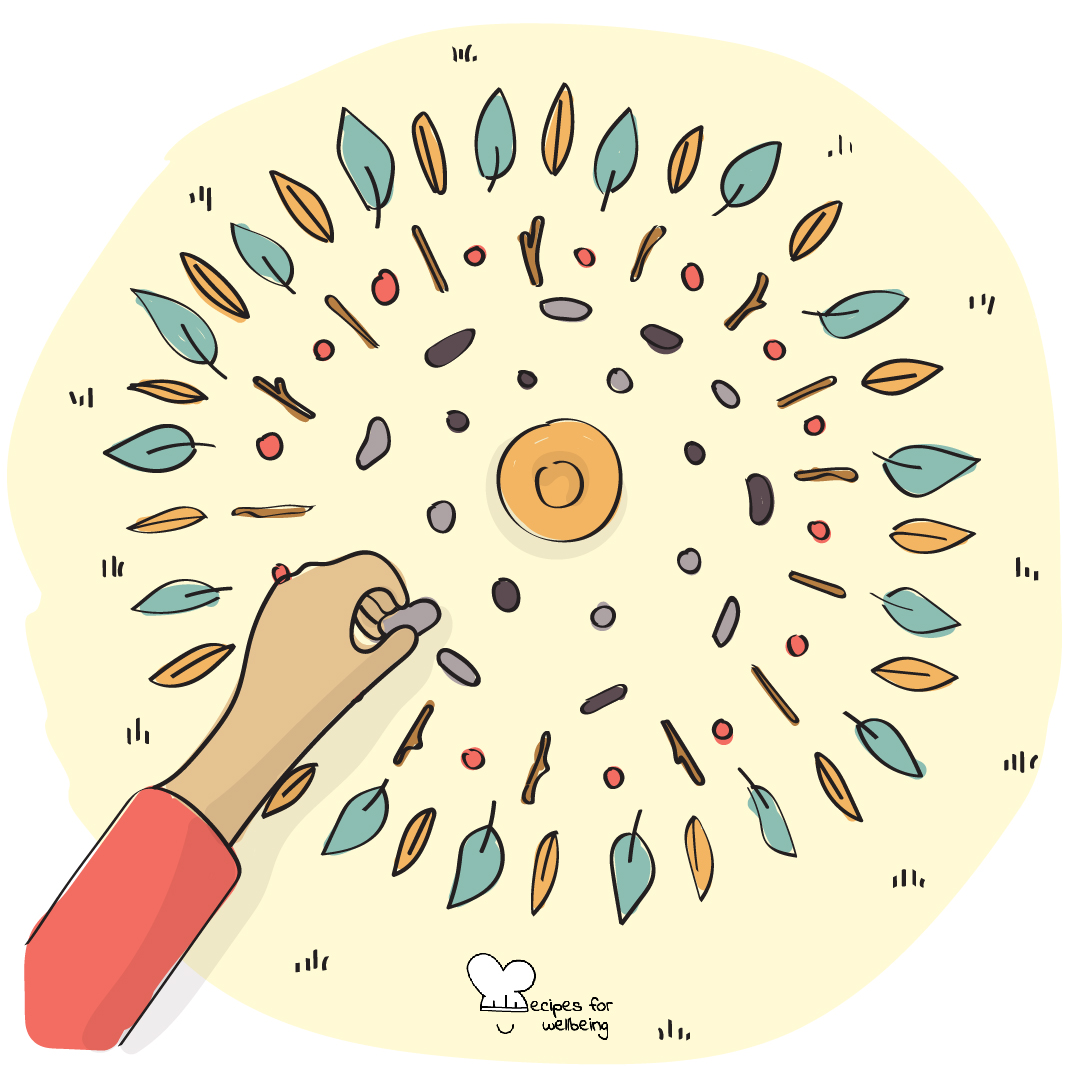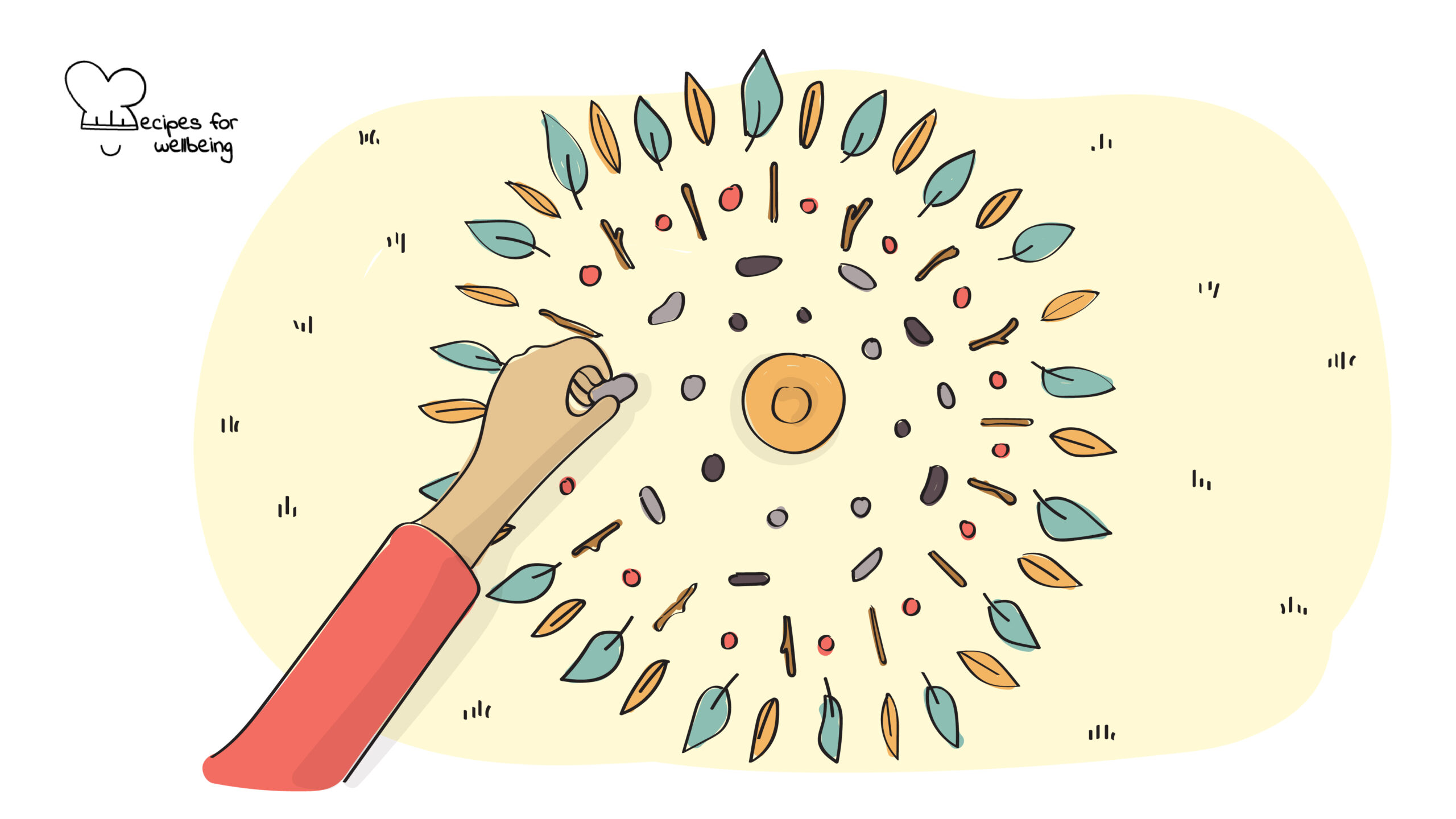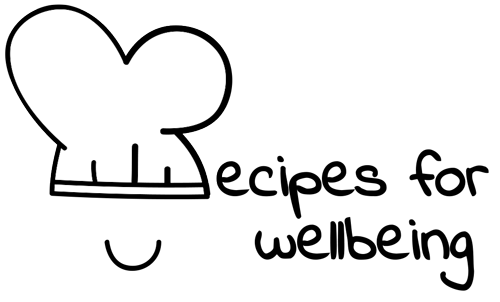
Truth mandala
The Tibetan word for mandala is kyilkhor. Kyil means ‘center’, khor means ‘fringe’, ‘gestalt’, ‘area around’. … Things exist interdependently, and that interdependent existence of things happens in the fashion of orderly chaos. ―Chögyam Trungpa
👥 Serves: 11-25 people
🎚 Difficulty: Hard
⏳ Total time: 61-120 minutes
🥣 Ingredients: A quiet place with no distractions, objects for the circle: stone, dry leaves, stick, empty bowl, cushion, “Coming back to life” book by Joanna Macy (if you’re curious to find out more about it!)
🤓 Wholebeing Domains: Discomfortability, Radical Care, Ritualising
💪 Wholebeing Skills: Acceptance, Adaptability, Caring, Compassion, Empathy, Grieving the future, Holding space, Nature kinship, Storytelling, Vulnera-bravery

Truth mandala
📝 Description
A ritual to honour our pain for the world so as to heal from it.
The following activity has been taken from Joanna Macy’s book Coming Back to Life. In Joanna’s own words, “this ritual exercise provides a simple, respectful, whole group structure for owning and honoring our pain for the world, and for recognizing its authority and the solidarity it can bring. The practice emerged in 1992 amidst a large, tension-filled workshop in Frankfurt, on the day of reunification between East and West Germany; since then it has spread to many lands. To many participants it has been the most significant experience in a workshop, if not in their lives.”
This exercise offers people in a group, community, or organisation the opportunity to explore and share their pain for the world, as this is a necessary step to renew their commitment and dedication to social change. It is also important because it shows the interconnectedness and complexity of the issues they face around the world, and presents a heterogeneous and diverse view of the field of changemaking and social activism. Because this exercise is emotionally charged, we invite you to do it in a group that has a safe space where vulnerabilities are not only welcome, but valued. Confidentiality is essential.
👣 Steps
Step 1 – Set up the circle (10’)
People sit in a circle. They sit as closely-packed as possible for they are, as we often put it, creating a containment vessel – or an alchemical vessel for holding and cooking the truth. The circle they enclose is divided into four quadrants (visible demarcations are not needed), and in each quadrant is placed a symbolic object: a stone, dead leaves, a thick stick, and an empty bowl. Entering each quadrant, the facilitator holds the object it contains and explains its meaning. Here are some words we use.
- STONE: This stone is for fear. It’s how our heart feels when we’re afraid: tight, contracted, hard. In this quadrant we can speak our fear.
- DRY LEAVES: These dry leaves represent our sorrow, our grief. There is great sadness within us for what we see happening to our world, our lives, and for what is passing from us, day to day.
- STICK: This stick is for our anger. For there is anger and outrage in us that needs to be spoken for clarity of mind and purpose. This stick is not for hitting with or waving around, but for grasping hard with both hands – it’s strong enough for that.
- EMPTY BOWL: And in this fourth quadrant, this empty bowl stands for our sense of deprivation and need, our hunger for what’s missing – our emptiness.
There is also a cushion at the centre of the four objects, for those who want to share something that does not fit one of the quadrants provided.
Step 2 – Share and listen (105’)
One person at a time, randomly and spontaneously, steps into the circle and takes an object in their hands and speaks. A person can speak from just one quadrant and leave, or more from one quadrant to another. It is okay to also just hold an object and not speak. People may come in more than once or not at all; there is no pressure on anyone to enter.
Encourage brevity in what is spoken, pointing out the relationship between the brevity and the power of a statement. The Truth Mandala is not for lectures or reports, but for direct and simple expression of our pain for the world. Let the ritual object itself help focus the mind. In the Truth Mandala we speak not only for ourselves, but for others, too. It is the nature of all rituals. that it allows us to speak archetypally – not just as separate individual selves, but on behalf of our people, our Earth.
To support the truth-telling, suggest a refrain – “I hear you” or “We hear you” – that people in the group will say, during or after each speaking in the Mandala. Confidentiality is essential; what’s said here stays here. A person’s words in the Mandala are not to be referred to afterwards. No personal references to those present will be made and no cross talk or responses to what others have said. People should also feel free to speak in their mother tongue.
Step 3 – Close the circle (5’)
The formal closing of the Truth Mandala is a key moment, in which to enlarge the group’s understanding of what has transpired. First the facilitator, speaking generally and on behalf of all, honours the truth that each has spoken and the respectful support that each has given. Truth-telling, as Joanna says, is like oxygen: it enlivens us. Without it we grow confused and numb. It is also a homecoming, bringing us back to powerful connection and basic authority.
Then share the deeper import of each quadrant in the mandala. Each symbolic object is like a coin with two sides; the courage to speak our fear, for example, is evidence of trust. Indicating one object after another, we say in effect: Please notice what you have been expressing and hearing. In hearing fear, you also heard the trust it takes to speak it. The sorrow spoken over the dead leaves was in equal measure love. We only mourn what we deeply care for. “Blessed are they that mourn.” Blessed are those who weep for the desecration of life, because in them life still burns clear. And the anger we heard, what does it spring from but passion for justice? The empty bowl is to be honoured, too. To be empty means there is space to be filled.
Step 4 – Break and debrief
Make sure to give people a long break after the ritual is complete where they can debrief with others (or with themselves) on the experience they just went through. Do not jump in another activity right away.

